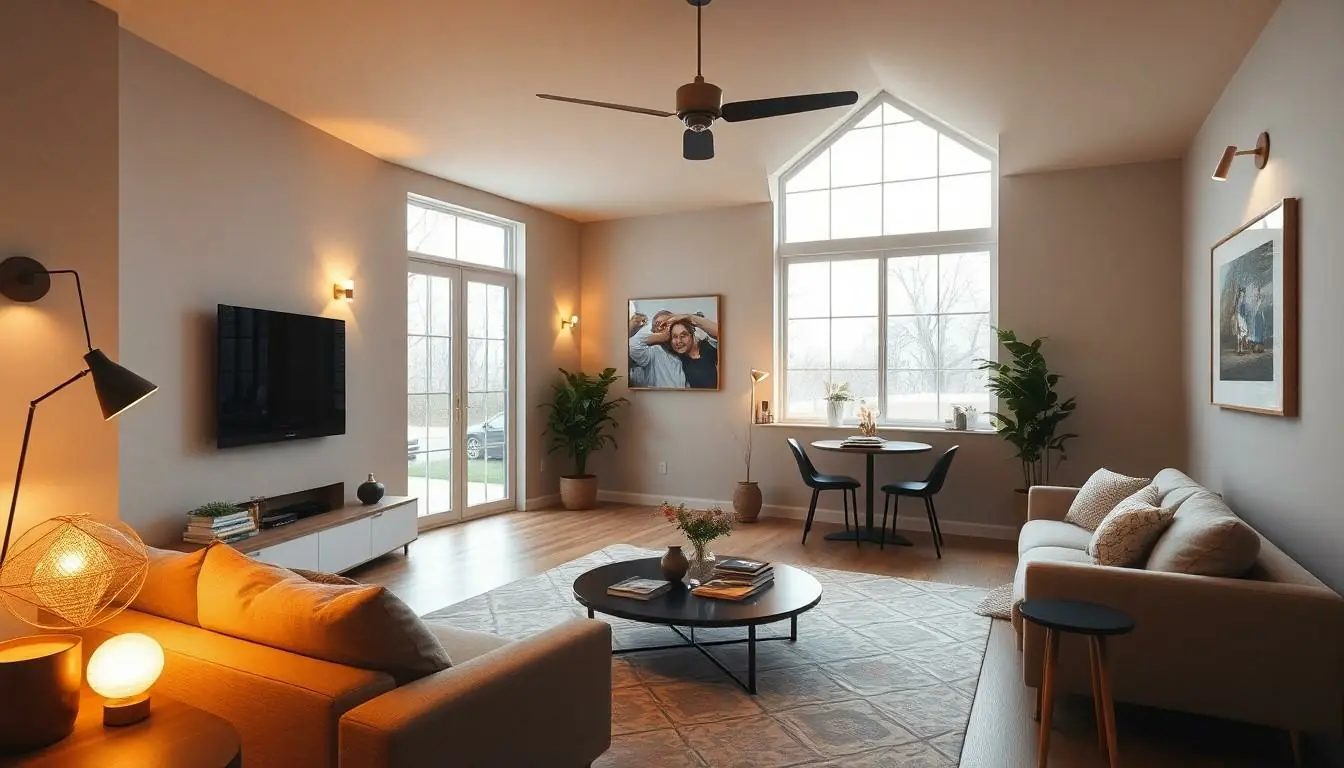Home lighting design isn’t just about flipping switches—it’s the secret ingredient that transforms a house into a cozy haven or an uninspired cave. Imagine walking into a room that feels as warm as a hug or as bright as your favorite coffee shop. With the right lighting, he can create moods that even a master chef would envy.
Table of Contents
ToggleUnderstanding Home Lighting Design
Effective home lighting design significantly impacts a space’s ambiance and functionality. Selecting the right lighting enhances a room’s aesthetic while meeting practical needs.
Importance of Lighting in Home Design
Lighting plays a crucial role in shaping a home’s atmosphere. It establishes mood and highlights architectural features. Proper illumination creates a welcoming environment that enhances comfort. Effective lighting can even influence productivity and well-being. Studies indicate that different lighting levels improve focus during tasks or relaxation during leisure time.
Types of Lighting: Ambient, Task, and Accent
Home lighting comprises three main types: ambient, task, and accent. Ambient lighting serves as the primary source of illumination, providing an overall glow. Task lighting directs light towards specific areas, offering support for activities such as reading or cooking. Accent lighting adds drama, drawing attention to art or architectural details. Each lighting type works together to create a harmonious environment that serves various needs throughout the day.
Key Elements of Home Lighting Design
Home lighting design revolves around several key elements that enhance aesthetic appeal and functionality. Understanding these aspects contributes to creating effective, inviting environments.
Choosing the Right Fixtures
Selecting the right fixtures ensures that residential spaces receive the necessary illumination while aligning with design intentions. Various styles and sizes exist, catering to different room aesthetics and functions. Pendant lights add elegance to dining areas, while recessed lighting provides a clean look in modern spaces. Additionally, durability and energy efficiency matter. LED fixtures offer longevity and lower energy consumption, making them a practical choice. Layering different fixture types, such as combining sconces with chandeliers, establishes depth and visual interest.
Color Temperature and Its Impact
Color temperature significantly influences the mood and functionality of a space. Measured in Kelvin, it ranges from warm yellows to cool blues. Warm light, often between 2700K and 3000K, creates cozy atmospheres in living rooms and bedrooms. Cool light, typically above 4000K, enhances focus in workspaces, promoting productivity. Additionally, specific areas benefit from defined temperatures; kitchens thrive under cooler tones, while relaxation spaces require warmer lighting. Utilizing adjustable lighting allows flexibility in mood settings, adapting to various activities and times of the day.
Techniques for Effective Home Lighting
Effective home lighting involves strategic techniques to enhance both aesthetic appeal and functionality. Implementing these methods can maximize a space’s potential.
Layering Light for Depth
Creating layers of light promotes visual interest and versatility. Ambient lighting functions as the foundational layer, providing general illumination. Task lighting targets specific activities, such as reading or cooking, ensuring adequate brightness where needed. Accent lighting highlights distinctive features like artwork or architectural elements, adding dimension. Combining these three types establishes a balanced and inviting atmosphere. More options exist, including dimmers and smart controls, allowing for adjustments based on the time of day or activity. Effective layering leads to a dynamic space that adapts to various moods.
Utilizing Natural Light
Harnessing natural light maximizes brightness and enhances well-being. Positioning mirrors strategically can reflect sunlight, expanding the perception of space. Windows and skylights invite daylight indoors, promoting energy efficiency and reducing reliance on artificial lighting. Choosing sheer curtains or blinds allows for light diffusion while maintaining privacy. Optimizing the layout to embrace sunlight improves a room’s ambiance and provides a connection to the outdoors. Regular maintenance of windows ensures unobstructed light flow. By utilizing natural elements creatively, homeowners can create an uplifting and vibrant environment.
Common Mistakes in Home Lighting Design
Home lighting design requires careful consideration to avoid common pitfalls that diminish its effectiveness.
Avoiding Overly Harsh Lighting
Overly harsh lighting creates discomfort and can lead to eye strain. It’s essential to choose light fixtures that diffuse and soften brightness. During the selection process, consider using dimmers to adjust intensity according to the time of day or activity. Soft white bulbs tend to foster a warm and welcoming ambiance, especially in living areas. Conversely, LED lights with high Kelvin ratings might enhance productivity but can feel too clinical for cozy spaces. Placing lamps with shades in strategic locations reduces glare while still illuminating needed areas effectively.
Neglecting Functionality
Functionality plays a crucial role in effective lighting design. Task lighting, designed for specific activities, should not be overlooked. Identifying key areas like reading nooks or kitchen workspaces warrants dedicated light sources for better visibility. By mixing ambient and task lighting, homeowners can achieve a balanced environment that caters to various functions. Assess specific needs for different rooms to ensure adequate lighting enhances usability. Interactive lighting solutions that adjust according to activity level can significantly improve both comfort and efficiency within each space.
Conclusion
Home lighting design plays a pivotal role in enhancing a space’s atmosphere and functionality. By thoughtfully combining ambient, task, and accent lighting, homeowners can create inviting environments that cater to various activities and moods. The right fixtures and color temperatures not only elevate aesthetic appeal but also promote well-being and productivity.
Incorporating natural light and employing layering techniques can further enrich the overall experience. Avoiding common pitfalls like harsh lighting ensures comfort and visual harmony. With careful consideration and creativity, anyone can transform their home into a beautifully illuminated haven that reflects their personal style and meets their practical needs.



